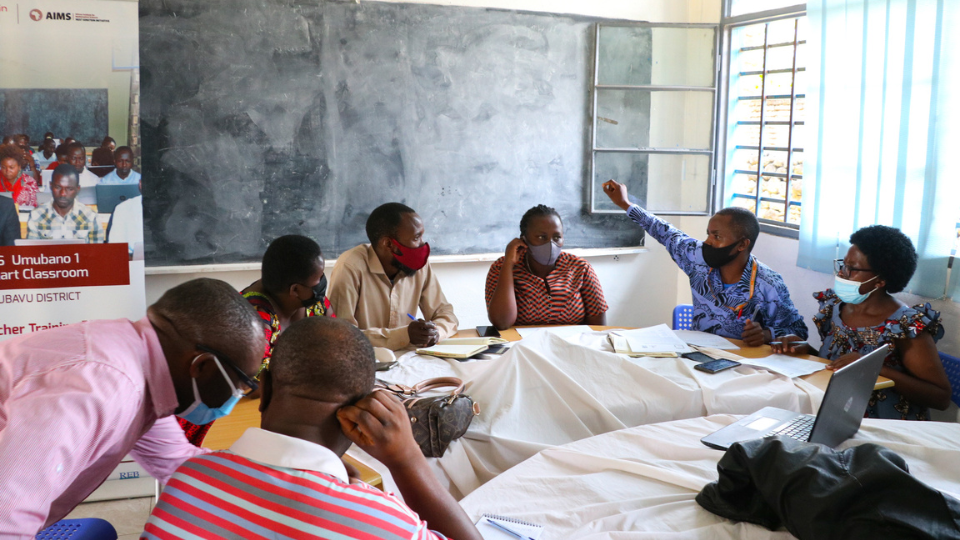The ’missing middle’: emerging evidence on the middle tier
The ’middle tier’ is perhaps not a term which is heard with much frequency in many parts of the education sector, but it is a locus of huge potential to improve education systems at scale. This space is occupied by a broad range of professionals – many of whom are experienced education practitioners – from instructors and coaches to inspectors and supervisors, who can act as key intermediaries between central ministries of education and individual schools. Used effectively, they can be central to effective translation of education policy into practical action which makes a tangible difference to teaching quality and learning outcomes.
We might therefore wonder why this group has so often been neglected in research and policy debates, with the focus instead falling on either high-level ministry decisions or – most often – on individual schools, teachers and headteachers. This is perhaps in part because the middle tier has often been viewed largely as an administrative and enforcement mechanism, rather than as an active partner in policy implementation – and especially in instructional leadership. Over-reliance on compliance-oriented interventions has undermined its importance. However, our research makes it clear that where middle-tier actors (most notably instructional leaders) are given agency and training to further their roles, rather than acting as enforcers in a purely top-down policy delivery approach, the middle tier has the potential to become an active learning, problem-solving organisation with real potential to effect sustainable change.
Indeed, the emerging evidence base explored in our work with IIEP-UNESCO (detailed in our reports: Leading Learning Together: the role of the middle tier and Change agents: emerging evidence on middle-tier leadership) suggests that middle-tier professionals are delivering these improvements in five key ways, by providing support for teachers and school leaders, promoting professional collaboration within and across schools, brokering knowledge to promote the use of evidence, providing instructional direction and system alignment, and scaling up promising practices. However, the evidence also shows the importance of balancing these roles – supportive roles, for example, must be carefully balanced with oversight and accountability to ensure the best outcomes for teachers and learners.
Linking policy with school-level reform: the benefits of a strong middle tier
The potential benefits of effective work in the middle tier of education systems matter hugely for education policy. Effectively linking policymaking at the central level with the implementation of reforms in schools is critical for strengthening learning capacity in education systems – and such links are best facilitated by trained, well-resourced professionals who can effectively engage with teachers and school leaders to share tailored knowledge and best practice, rather than simply ticking boxes to ensure generic compliance. There are several ways in which these professionals can perform that highlight the importance and relevance of these links within education systems.
First, the middle tier can provide crucial intelligence to help central governments to better understand the needs of teachers and schools. The proximity of middle-tier professionals to teachers and schools gives them a unique opportunity to understand the real-world issues and challenges faced by teachers and school leaders in their respective contexts. These leaders are then in a position to feed such information back to central ministries to inform policy and planning. In Wales, for example, associates in the National Academy for Education Leadership (who are themselves instructional leaders and practicing headteachers) contribute to the formation of national policy by bringing the perspective of frontline staff into the process.
Middle-tier professionals can also use their understanding of local contexts and systems to help develop and deliver practical solutions to key problems within the system. This enables them to act not only as a delivery mechanism for policy implementation, but also as a collaborative partner for teachers, enhancing professionalism, equity and wellbeing within the education workforce. In these ways, middle-tier professionals have a unique dual ability to both support individual classrooms and to drive wider systemic change. This is well illustrated by the work of Teaching Research Officers in Shanghai, who use insights generated in group lesson observations both to help teachers improve their practice and to inform the development of curriculum materials.
Maximising the benefits of the middle tier: an enabling environment
While the potential benefits of a skilled middle-tier workforce are becoming increasingly clear, our analysis suggests several provisos to ensure its effectiveness. These are centred on two key themes: professionalisation of the middle tier and an enabling culture of trust and collaboration.
Professionalisation: building capacity through recruitment, training and role design
Investment in strengthening and professionalising the middle tier – for example, by investing in recruitment policies, offering enhanced professional status and prioritising high-quality professional development opportunities – is key to creating an effective workforce which can drive meaningful change.
Recruitment and training practices are particularly critical in this regard. In many countries, the capacity of the middle tier is often constrained by historical structures around such practices. For instance, administrative leadership positions may be given to headteachers nearing retirement on the basis of years of service or political expediency, rather than on the basis of exceptional performance, and professional development activities for these workers once in post are often limited. Such barriers may be challenging to address, but our analysis suggests that when innovative strategies are put in place to strengthen these roles and workforce systems, the pace of change can be increased, and middle-tier professionals can become lynchpins in education reform.
This may involve the creation of new roles. In Rwanda, for example, a new position, ‘Leader of Learning’ was created, with postholders being competitively selected from headteachers whose practice is considered exemplary. These leaders of learning work across their locality to offer professional development support to their peer headteachers, thereby acting as agents of change beyond the context of their own schools. Their roles have been associated with professional and cultural changes in the Rwandan education system, including the promotion of a culture of collaborative learning across schools and districts, and have generated measurable improvements in the instructional leadership skills of head teachers.
That said, radical restructuring will not always be necessary: high-quality training or re-training for existing middle-tier staff can also translate to significant impact. An example from Jordan illustrates how existing middle-tier roles can be strengthened to direct them towards effective instructional leadership for teachers. Middle-tier supervisors were trained in evidence-based supervision for teachers, in which they partnered with teachers to evaluate the causes of student learning outcomes and apply pedagogical interventions, drawn from robust evidence about teacher effectiveness. This better enabled supervisors to partner with teachers as ‘critical friends’, both to support them and to hold them accountable for their progress. As a result, teachers flourished and their practice improved.
A culture of trust, collaboration and learning
The effectiveness of the middle tier is maximised when there is a culture of trust and collaboration that spans right from the upper levels of the education system down to individual schools. Such a culture can be facilitated by providing adequate agency to middle-tier professionals, who in turn can build meaningful, impactful relationships with the schools and individuals with whom they work.
Middle-tier actors are most effective when they have appropriate agency and autonomy. A critical factor in the success of reforms is the empowerment of middle-tier actors to exercise their professional judgement. This follows from appropriate recruitment and training: where these factors are in place, senior stakeholders are more able to trust middle-tier professionals to interpret and adapt broad policy directions and make them relevant to school professionals in their locality. Policymakers could thus be confident they were harnessing extensive practitioner knowledge and local influence, and see middle-tier actors as allies in change processes, rather than simply as administrators applying policy.
Moreover, it is increasingly clear that when middle-tier actors can build the trust of schools, teachers and headteachers, and work collaboratively to develop a culture of school improvement, meaningful change comes about more quickly. In translating policy measures to real changes in teaching practice, it is critical that changes (especially those that relate to teaching quality) are internalised by schools and their staff. Relationship-building between middle-tier and school-level workers is an important part of this process, especially where it helps to overcome resistance to change. In Delhi, for example, the teacher development coordinator (TDC) role was created to provide supportive, trusted peers to help improve practice, but some teachers initially displayed reluctance to fully embrace the TDC programme. However, with the establishment of relationships between the TDCs and teachers, as well as time, patience, and open lines of communication, more and more personnel started to buy in to the support and collaboration offered by these instructional leaders, ultimately leading to substantial improvements in teaching practice.
Finally, in all of the case studies featured in our research, the adoption of a learning mindset by reform leaders was a key enabling factor. This ‘learning by doing’ mindset not only allowed time for the abovementioned trust and collaborative relationships to form, but also allowed for a gradual improvement in the working of the middle tier, absorbing new innovations and tackling emerging challenges.
It seems clear that the middle tier – as a locus of knowledge and understanding of both ministry priorities and school realities, as well as of instructional leadership and accountability – has huge potential for enacting meaningful, system-wide change. It should therefore be viewed not merely an afterthought in the design of education reforms, but as a key consideration and potentially powerful partner in improving teaching and learning outcomes for all.
For further details on the examples mentioned above, you can access our report here.
Recommendations for policymakers
Based on the insights and considerations described above, we have identified four key recommendations for policymakers seeking to create an enabling environment for effective education reform at the middle tier. They are:
- Invest in the professionalisation of the middle tier: the potential reach of postholders in this tier of the education system means that, if well selected and resourced, they are likely to demonstrate a good return on investment.
- Reform middle-tier positions to ensure that roles are appropriate for meeting key functions and that structures build capacity for change – rather than constituting an expensive administrative burden.
- Ensure that recruitment is appropriate, selecting skilled practitioners, where relevant, to participate in instructional leadership.
- Ensure that reforms enable collaboration and relationship-building between schools and the middle tier, to help reduce resistance to change and embed good practice.





